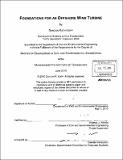| dc.contributor.advisor | Andrew J. Whittle. | en_US |
| dc.contributor.author | Kopp, Duncan Rath | en_US |
| dc.contributor.other | Massachusetts Institute of Technology. Dept. of Civil and Environmental Engineering. | en_US |
| dc.date.accessioned | 2011-01-26T14:21:01Z | |
| dc.date.available | 2011-01-26T14:21:01Z | |
| dc.date.copyright | 2010 | en_US |
| dc.date.issued | 2010 | en_US |
| dc.identifier.uri | http://hdl.handle.net/1721.1/60766 | |
| dc.description | Thesis (M. Eng.)--Massachusetts Institute of Technology, Dept. of Civil and Environmental Engineering, 2010. | en_US |
| dc.description | Cataloged from PDF version of thesis. | en_US |
| dc.description | Includes bibliographical references (p. 75-76). | en_US |
| dc.description.abstract | Worldwide energy demand is growing rapidly, and there is great interest in reducing the current reliance on fossil fuels for uses such as power generation, transportation, and manufacturing. Renewable energy sources, such as solar and wind, are abundant but have very low power densities. The US is in the process of approving its first offshore wind farm, located in Nantucket Sound. Geotechnical factors will play a large role in the development of offshore wind projects due to the high cost contribution from foundations, and the high loads associated with storm conditions. Offshore wind turbine foundations provide unique design challenges. First, various foundation alternatives exist, so it is important that an appropriate cost-effective foundation type be selected. Second, the loads and soil conditions will vary for each location. Therefore, it is important to ensure the foundation can adequately support vertical and horizontal loads. Finally, each turbine manufacturer has unique deflection and rotation criteria. Therefore, the foundation should perform within those tolerances, even under worst-case loading. This thesis considers the performance of a monopile foundation under typical vertical and horizontal storm loading conditions. Capacity, deflection, and rotation of a proposed monopile foundation are calculated by various methods to simulate the design procedure. The results show that very stiff foundations are required to keep pile head movements within design tolerances. | en_US |
| dc.description.statementofresponsibility | by Duncan Rath Kopp. | en_US |
| dc.format.extent | 123 p. | en_US |
| dc.language.iso | eng | en_US |
| dc.publisher | Massachusetts Institute of Technology | en_US |
| dc.rights | M.I.T. theses are protected by
copyright. They may be viewed from this source for any purpose, but
reproduction or distribution in any format is prohibited without written
permission. See provided URL for inquiries about permission. | en_US |
| dc.rights.uri | http://dspace.mit.edu/handle/1721.1/7582 | en_US |
| dc.subject | Civil and Environmental Engineering. | en_US |
| dc.title | Foundations for an offshore wind turbine | en_US |
| dc.type | Thesis | en_US |
| dc.description.degree | M.Eng. | en_US |
| dc.contributor.department | Massachusetts Institute of Technology. Department of Civil and Environmental Engineering | |
| dc.identifier.oclc | 693567859 | en_US |
